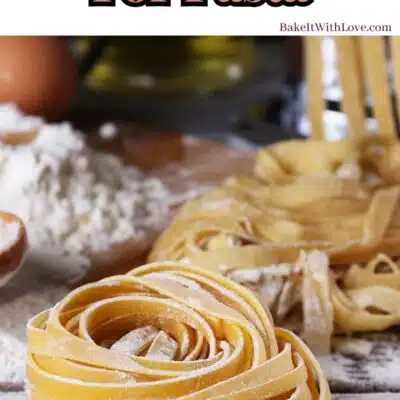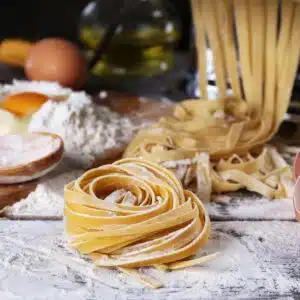The best flour for pasta is the varieties that have a higher protein count in order to give strength and flavor. With so many types of flour out there, knowing the right kind to use is important. This guide will show you the different types of flour and which ones are best for making pasta.
What Flour Varieties Can I Use To Make Pasta
Pasta is one of the world's most popular and diverse foods; making it from scratch can be a fulfilling part of meal preparation. Consisting of 3 basic ingredients (flour, water, salt, and sometimes eggs), pasta is relatively easy to make.

Jump to:
There are many different flour types with different protein levels, textures, and flavors. The higher the protein count (gluten), the more elasticity the dough will have.
Gluten makes the dough easy to knead, so you can form it into any shape you like. For pasta specifically, you'll want high-protein flour so it is firm enough to hold its shape without falling apart (ideally somewhere between 10-15% protein).
What Is Gluten
Gluten is the form of protein that is found in pasta. It is responsible for the pasta's elasticity, stretchability, and strength. The more gluten there is, the firmer the pasta will be.
Firmness is the key necessity with pasta, whereas baked goods require more tender textures.
Best Types Of Flour For Pasta
1. All-Purpose Flour
All-purpose flour is a versatile flour that can be used to make a variety of foods. It can be used to make pasta, but it has a lower amount of protein than the other options on this list.
With 8-11% protein, it works just fine for making pasta, but it will take some extra kneading to achieve the ideal level of gluten development.
However, all-purpose flour is the type that most people already have in their pantry. You can certainly use it if that's all you have or if you don't want to go searching for more specialty flour.
2. Semolina Flour
Semolina is considered one of the best flours to make pasta. It is a course flour variety made from durum wheat (which gives it a natural golden color).
It has a high protein content of up to 13% and gives a rougher texture, which is excellent for shapes and holding sauce.
3. 00 Flour
00 Flour is a very fine, softer flour perfect for making ravioli or tagliatelle pasta (or any variety if you want a smooth texture). It is also a favorite in Italian cooking called Farina Tipo 00 in Italy.
It is also a popular flour for pizza dough and baked goods. Unfortunately, 00 flour is also more expensive because mills lose close to 30% after it is grained.
Semolina is often used as a substitute for 00 flour, too, as they both have the same level of protein.
>>>>See all of my recipes here<<<<
Using Other Types of Flour For Pasta
There are a ton of different types of flour. Above, I've listed the best 3 for making pasta, but feel free to experiment with the type of flour you want to use.
You can make them work, but some flours will require a lot of effort, so they might not necessarily be worth it.
Remember that using different flour varieties can affect the recipe, causing you to require more or less liquid. The texture will also change, as soft flour (like cake flour or pastry flour) will yield pasta that is incredibly soft.
The only type of flour that I really don't recommend using is self-rising flour, as it has added baking powder.
Best Flour For Making Pasta
The best flour for making pasta would be semolina or a combination of semolina and 00 flour. It will create your traditional rustic pasta, is easy to knead, and can be used to make any shape.
If you don't have these specialty flours, then all-purpose flour would be the next best choice.
Which flour is your favorite for preparing pasta? Let me know your thoughts in the comments!
Do you love a recipe you tried? Please leave a 5-star 🌟rating in the recipe card below and/or a review in the comments section further down the page.
Stay in touch with me through social media @ Pinterest, Facebook, Instagram, or Twitter! Subscribe to the newsletter today (no spam, I promise)! Don't forget to tag me when you try one of my recipes!
📖 Recipe Card
Best Flour For Pasta: Creamy Smoked Salmon Pasta (+More Information!)
Ingredients
- 12 oz fettuccine (or your preferred pasta)
- 2 tablespoon butter
- 2 shallots (thinly sliced)
- 1 teaspoon garlic (minced)
- 2 cups heavy cream
- ¼ teaspoon each, salt & pepper
- ¼ teaspoon paprika
- 5-10 oz smoked salmon (cut into chunks)
- ¼ cup Parmesan cheese (grated)
- 1 pinch dried dill (or 1 tablespoon fresh dill or parsley for garnish)
(Note: 2x or 3x only changes the ingredient list)
Instructions
- Follow the directions on your box of 12 oz fettuccine and cook it 1-2 minutes shy of al dente. Reserve 1 cup of the pasta water, then drain the noodles and rinse them under cool water to stop them from cooking.
- Melt 2 tablespoon butter in a large skillet over medium heat. Once melted, add the 2 shallots and1 teaspoon garlic and saute until fragrant (about 2 minutes),
- Pour 2 cups heavy cream into the skillet and season it with ¼ teaspoon each, salt & pepper and ¼ teaspoon paprika. Increase the heat to high and bring to a boil.
- Once the cream is boiling, return the pasta to the skillet and let it cook. Stir occasionally (every 2-3 minutes) until most of the liquid has been absorbed by the pasta. *If your sauce is too thick, add small amounts of the reserved pasta water to thin it out as needed
- Toss in 5-10 oz smoked salmon and remove from heat. Sprinkle ¼ cup Parmesan cheese on top and garnish with 1 pinch dried dill if desired.
Notes
- You can use any long noodle variety to make this recipe. Linguini, tagliatelle, or spaghetti would all make fine alternatives to fettuccini.
- Freshly grated Parmesan cheese will melt significantly better than the pre-packaged stuff. This is one of those recipes where it pays off to grate your own cheese!
- The pasta is going to cook to perfection in the sauce, so it's best to stop boiling it 1-2 minutes before the recommended time on the package.
- To store: Let the leftovers cool completely, then transfer them to an airtight storage container and refrigerate for up to 3-4 days.
- To reheat: For large quantities, add the pasta to a baking dish and cover it with foil. Reheat in the oven at 350°F (175°C) for 10-15 minutes or until warmed through. Individual portions can be reheated in the microwave.



Comments
No Comments